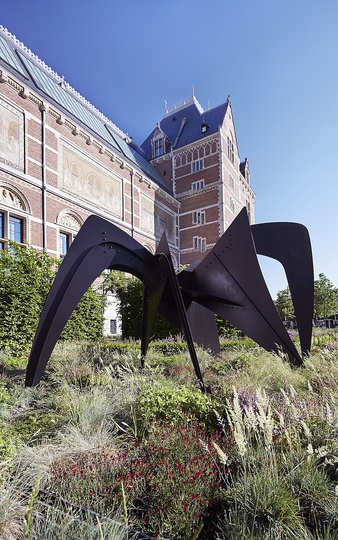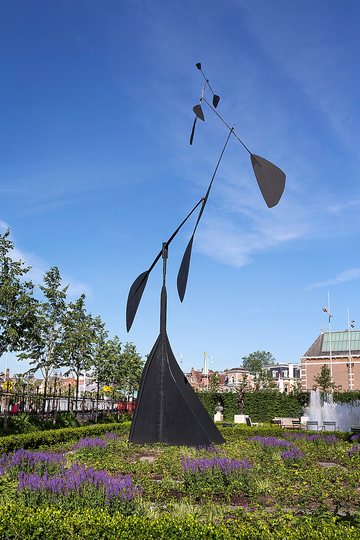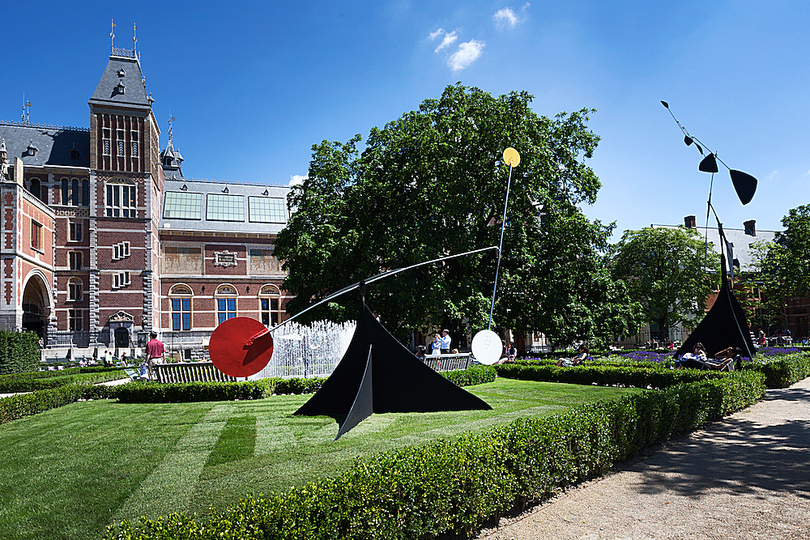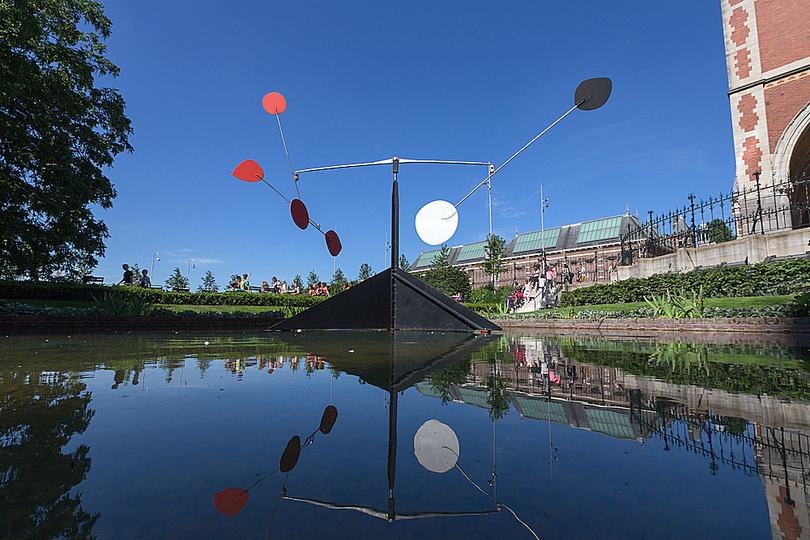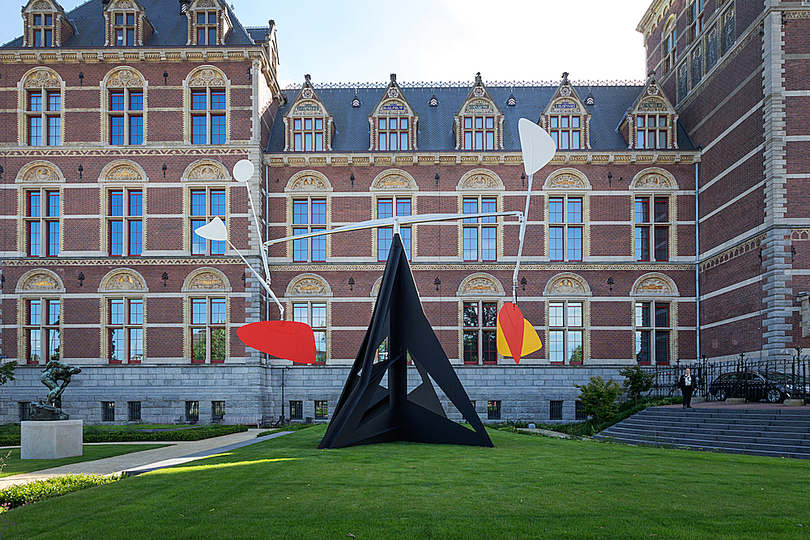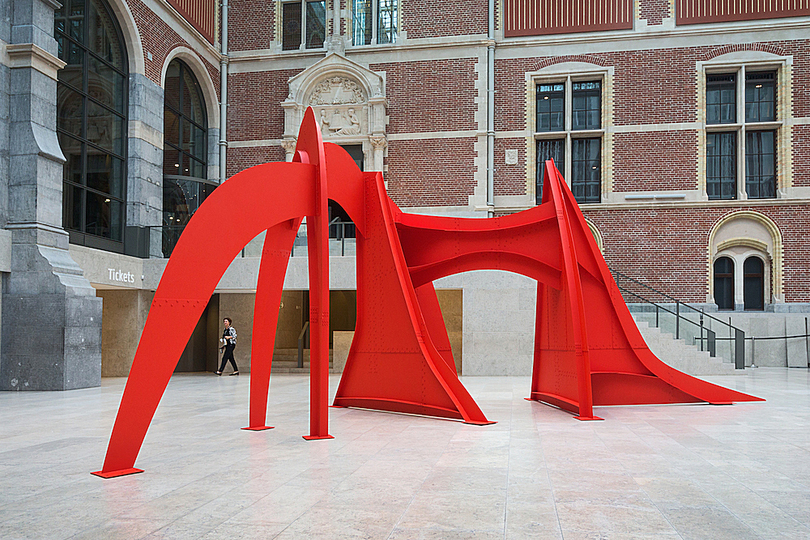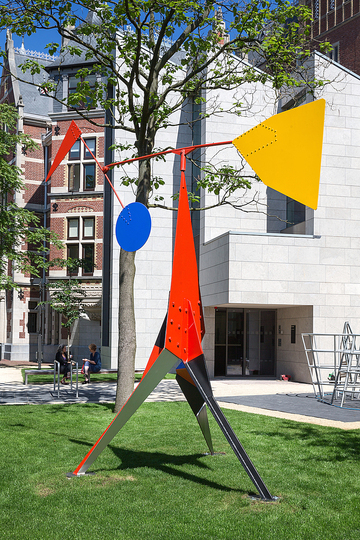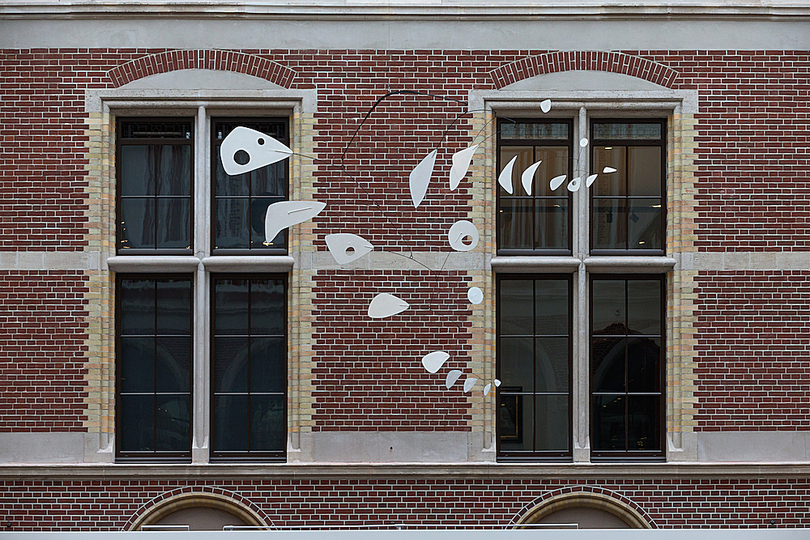Kinetic Sculptures by Alexander Calder
Born in America into a family of sculptors, Alexander "Sandy" Calder initially started out as a figurative sculptor and painter. While living and working in Paris as a painter, he visited Mondrian´s studio in 1930 and was deeply impressed by the aesthetics of abstraction. Soon abandoning painting, Calder developed the ambition to create moving colored shapes: after some experiments with a motor, he started creating light structures suspended from the ceiling, set in motion through a breath of air.
In 1931, it was Marcel Duchamp who applied the term ´mobiles´ to his kinetic works, which, for almost the first time in art history, formalized real movement in sculpture. The precarious balance of the shapes, like leaves on the branches of a tree, shows a very special talent, helped by his training as an engineer. His first works were delicate figures in steel wire where the artist showed an amazing skill in his use of the material: Calder at that time designed toys, animals, and three-dimensional portraits of his friends, and he articulated characters of a miniature circus, which he presented in public performances with great success.
The development in scale of his works led him to invent a parallel category, the stabiles - a term introduced by Jean Arp in 1932 - where large sheets of generally black metal are assembled to create dynamic structures, sometimes in very large dimensions, to which Calder devoted himself from the 1950s onward. In some cases a mobile structure made up with abstract shapes sways at the top of the sculpture, creating so-called standing mobiles.
An excellent selection of Calder´s mobiles, stabiles, and standing mobiles will be on view at the Rijksmuseum sculpture garden until October 5th. Images courtesy: Rijksmuseum, Amsterdam.
Alexander Calder, La Spirale, 1958. Unesco Works of Art Collection © 2014 Calder Foundation, New York / Artists Rights Society, New York. Photo: Olivier Middendorp
Alexander Calder, Brasilia, 1965. Collection Fondation Pierre Gianadda, Zwitserland © 2014 Calder Foundation, New York / Artists Rights Society, New York. Photo: Olivier Middendorp
Alexander Calder, Zonder titel II, 1970. Particuliere collectie Londen © 2014 Calder Foundation, New York / Artists Rights Society, New York. Photo: Olivier Middendorp
Alexander Calder, Five Empties, 1973. Calder Foundation, New York © 2014 Calder Foundation, New York / Artists Rights Society, New York. Photo: Olivier Middendorp
Alexander Calder Foundation, New York. Donation of the Philip & Muriel Berman Foundation, 2005 © 2014 Calder Foundation, New York / Artists Rights Society, New York. Photo: Olivier Middendorp
Alexander Calder, Crinkly, 1969. Centre National des Arts Plastiques, Paris © 2014 Calder Foundation, New York / Artists Rights Society, New York. Photo: Olivier Middendorp
Alexander Calder, Le 31 Janvier, 1950. Musée National d'Art Moderne, Paris © 2014 Calder Foundation, New York / Artists Rights Society, New York. Photo: Olivier Middendorp
Inspirations.
This City
This City is an audio-visual piece performed as musical alter-ego Mark Eats. It explores what happen...
HOKUSAI X MANGA
Courtesans, Heroes, Stars and Phantoms - In the early seventeenth century, Edo, which was the bigges...
The Glass House
"This house was Philip Johnson's autobiography—all of his interests were visible, and all of his a...
The Oily Actor
“I had been looking around these ideas of systemic crisis, global financial crisis, which is what ...
Julius Shulman: Visual Drama
"Julius had an eye for visual drama. With modernist buildings, he loved capturing the strong lines s...
Standing wave Sculpture
Standing wave morphology by Gabriel Kelemen 1995
Jewelry Design Art
Jewelry Art design pattern inspired from nonlinear dynamics.
Drawings collection about fluid flows...
Bring the outside in: The houses of Joseph Eichler
“Eichlers,” as they are referred to in California, are midcentury modern tract homes developed b...
DADAMAINO
“I have always loathed the material and have always sought the immaterial”
Dadamaino (Emilia Edo...
Mass, space, plane and line
"The essence of architecture is the interrelation and interaction of mass, space, plane and line. Th...
Superheroes
Paola Mathe, born in Petionville, Haiti, lives and works in New York City. She holds a BA in econom...
German Painting after the 1960s
What is so 'German' about the art made by German painters and sculptors after the 1960s to now? The ...
David Bowie is Crossing the Border.
This is a tribute to the musician, artist, designer, and dandy David Bowie (January 8th, 1947-Januar...
Sadamitsu Neil Fujita
Sadamitsu Fujita was born in Waimea, Hawaii to Japanese immigrants. He attended boarding school in H...
Stan Galli
Illustrator Stan Galli (1912 - 2009) attended the California School of Fine Arts and was recruited a...
Spacecraft
Raised in Maryland, Nicholas Alan Cope moved to Los Angeles in 2004 and attended Art Center College ...
Mirrors
Jeannette Montgomery Barron was born in 1956 in Atlanta and studied at the International Center of P...
The Way Of The Light
Vasa Mihich studied at the Academy of Applied Arts, University of Belgrade, Yugoslavia. Mihich has l...
Radebaugh and Bohn
Arthur C. Radebaugh (1906-1974) was an American illustrator, airbrush artist, and designer. Some of...
Silent Geography
Silent Geography is a site-specific installation consisting of Hazard's torn paper constructed lands...
John James Audubon and the Golden Eagle
R Kikuo Johnson grew up on the island of Maui. He began a career in cartooning and illustration wit...
Forward Retreat
Mark Tansey was born in California. He attended art classes at the San Francisco Art Institute and s...
Afflicted Objects
"When I was 22 years old I found myself pacing the hallucinogenic black & white sidewalks of Rio de ...
Ramona Rosales Portraits
Photographer Ramona Rosales lives and works in Los Angeles.
Low Tech
Kevin Twomey´s first study of light came from studying theatrical lighting where he learned the abi...
New York by Louis Faurer
Louis Faurer (1916 – 2001) was an American fashion and street photographer. The significance of h...
Labyrinth
Pieterjan Gijs and Arnout Van Vaerenbergh: Labyrinth at the C-mine art centre in Genk, Belgium. The...
Things As They Are
Erin O´Keefe is a visual artist and architect based in New York City and New Brunswick, Canada. She...
Pryor Console
The CASTE line of furniture and accessories is designed by Ty Best. Ty was born and raised in Montan...
Europa ‒ Where it has been & Where it is at
What image represents Europe? Is it the fall of the Berlin Wall, universal human rights, the Europea...
Light of Thought
A representation of the brain is laboriously formed from thousands of drops of melted solder using a...
Postcards from Miami
Art Deco in Miami Beach. Photos (C) Mario Gagliardi
The Art of Ralph McQarrie
Ralph Angus McQuarrie studied at the Art Center School in Pasadena. He first worked for a dentistry ...
Édouard Vuillard: Turn of the Century Paris
A painter of interiors and park landscapes, Vuillard created his first lithograph series in black-an...
Paper sculptures
Paper sculptures by Richard Sweeney. Richard was born in Huddersfield, England in 1984. He studied a...
Icons of American Design: George Nelson
"Good design, like good painting, cooking, architecture or whatever you like, is a manifestation of ...
Eisenschokolade
Sculptures by Thomas Rentmeister.
1964
born in Reken / Westphalia, lives in Berlin
...
Deutschland
Design of painted wall texts by Rasmus Koch studio for artist Jens Haaning. In 2004, Jens Haaning wr...
Supercenter disruptions
Mass: an installation project about creating visual disruptions in places of mass. Mass is a site sp...
Printed Stone Fields
This project has started from a search for a 3d-objects optimal packing algorithm over a surface, bu...
Sisyphus
"Motion Control" is an industry term for computer-controlled movement in applications like robotics ...
Paolo Cirio: Overexposed
This artwork is composed of a series of nine unauthorized photos of high-ranking U.S. intelligence o...
Ghost: Kader Attia and Ventimiglia
The striking similarities between the installation of Kader Attia and the current situation in Venti...
Peak Oil
"I create sculptures based on sublime moments. These are moments that fill a person with amazement, ...
Nucleo
Nucleo is Piergiorgio Robino (1969) born in Asti, Stefania Fersini (1982) born in Aosta, Alice Carlo...
Architectural Fun Ride
Borrowing language from roller coasters, the “Architectural Fun Ride” is a block-long, program-l...
Fresh White
Four major arcana here: Fresh White is at a turning point, and a very positive one. The Sun and the ...
Jiyong Lee: Segmentation Series
The segmentation series is inspired by my fascination with science of cell, its division and the jou...
Monsters
"Monster" is a term designating this pile of objects abandoned in the street waiting to be taken awa...
American Modern Paintings at Sotheby´s
Sotheby's New York sale on Wednesday, May 20th totaled $38,301,625 reflecting the continuous health ...
Neighborhood
A bi-annual competition organised by architekturbild e.v. and Deutsches Architekturmuseum in Frankfu...
Amir Zaki: Southern California
Amir Zaki is a practicing artist living in Southern California. He received his MFA from UCLA in 199...
Minoru Yamasaki and Jean Baudrillard
Minoru Yamasaki, best known as the architect of the World Trade Center in Manhattan, created several...
Frank Stella: Radical Abstraction
In 1959, a newcomer in his early twenties takes New York’s art scene by storm: the American Frank ...
The New Social
From April 1st to Mary 31st 2015, twelve outstanding young European photographers will be presenting...
The Graffiti Table
The Graffiti dynamic is a three dimensional canvas which moves through the space between the floor i...
Sony World Photography Awards
Etienne Meneau
Etienne Meneau is best known for his "strange carafes". In addition to be an eye-catcher in every ho...
Shannon Goff
Shannon Goff works with sculpture, ceramics, and drawing. Goff received a BFA from University of Mic...
Francisco Sobrino: Geometry, Light and Movement
Francisco Sobrino (1932 – 2014) was one of the great geometric and kinetic artists of the 20th cen...
Landscape in my Mind
A network of connections between man and nature, the landscape presents itself as a projection of th...
Monet and the Birth of Impressionism
The nineteenth century was a time of upheavals. A wide variety of developments took place at the sam...
Stars in your eyes
Tim Lahan is an artist and illustrator living and working in New York. He’s the author of The Nosy...
PHOTOGENESIS
Material: translucent porcelain
Data sheet : 100-240V, 42 led, 10W,
The light source is exchange...
Paul Rand
A selection of work by eminent American graphic designer Paul Rand.
Islamic Art Now
The Los Angeles County Museum of Art (LACMA) presents Islamic Art Now: Contemporary Art of the Middl...
Constructing the sixties
"My personal practice focuses on America during the 1960s and 1970s. The works take the form of stag...
Contemporary Still Life
Works from the Sony Photography Award 2015 shortlist. © Courtesy of 2015 Sony World Photography Awa...
Imminent Reality
Maiko Gubler is a visual artist working with digital modeling tools in imagery and sculpture. After ...
Ghia Gilda
Chrysler’s executive Virgil Exner commissioned the Gilda showcar in 1955. It was designed by desig...
also:
Field of Notion
Field of Notion delves into the dichotomies of light and shadows, life and death, creating a series ...
Paintings 2024
An ongoing series of mixed media paintings
Eden
Paper sculpture
PAISAJES DE L'EMPORDÀ
Collage
SALTO
Sculpture
HISTORIA DE UN HUEVO
Sculpture
EL CAMINO MÁS LARGO
Sculpture
VEOVEO
Painting
COMECOCOS
Sculpture
ADELA
Sculpture
SÚBER
Sculpture
EQUILIBRIOS
Escultura
Shop Them - DR NOKI T-shirts are here!
penccil is happy to announce its launching of penccil shop <t https://penccil.com/shop with fashion ...
Tree Calligraphy
The fingers of the Ents splayed out reaching to connect with all who listen and feel.
briller par son absence
burn wood
expansion series
“Chaos and Catastrophe unbound,
worlds formed thrust together,
Colour and light rebounded,
befor...
All the Colour Drained Away
On days that the wind blows hard the leaves all seem to align the same way, the clouds roll in and t...
Looking West
Glimpses at sunset,
Snapshots of beauty,
How deep the sea,
Cliffs that soar away.
Imaginings of the ...
Discs and Plates
Swirls of colour, lines, spots, imaginary layers of depth brought out into the light by transparency...
Gin is the Thing
While searching for inspiration for sculpture, a friend was talking about the ideal glass for drinki...
PYROLYSIS
Artwork Statement: "PYROLYSIS"
What is it about fire?
So attractive, So lovely, desirable, reaching ...
Laurel Hills Residence
A beautiful example of a contemporary Californian residence, designed by Assembledge architects. The...
Los Angeles
Traveling with Google Maps
Pierre Bonnard: The Memory of Colors
In autumn and winter 2019/20 the Bank Austria Kunstforum Wien presented »Pierre Bonnard - The Color...
Objects of Desire
»Surrealism and Design 1924 – Today«
28.09.2019 – 19.01.2020 at Vitra Design Museum
Surrealis...
Francesco Vezzoli: Antique not Antique
Francesco Vezzoli at MUSEO MUSEION.
Rudolf Belling
Rudolf Belling was sculptor, designer, architect and stage designer. In 1908, he founded a studio fo...
Calatrava : Sculptures
Sculptures by architect Santiago Calatrava.
The e-scooter Boom
The German Ministry of Transport announced that it will legalize e-scooters as road vehicles. All Ge...
The Destroyer Doors
Pigment, mold, graphite, and mixed media on paper.
Trajectories of the Lost, Fallen, Forgotten, and Most Unclean
Ink, graphite, pigment, & mixed media on paper.
The shape of clouds
"Outside, the land stretches, empty, to the horizon; the sky opens, with speeding clouds. In the sha...
Black Box. A Cabinet of Robotic Curiosities
The Vitra Campus has a new exhibition space: in one of the houses at the southern entrance, a Black ...
The Joys of Ice Skating
That skating 400 years ago was one of the most popular winter activities in the Netherlands can be s...
serpentine 2017
exhibition, schauspiel köln, cologne. steelobjects, ceramic reliefs.
BS1
temporary accessible sculpture.
Wayne Sorce: Urban Color
"Wayne Sorce: Urban Color" is on view from October 21st through November 30th at Joseph Bellows Gall...
Franz Kline
Around 1950, Franz Kline radically simplified painting: “Instead of making a sign you can read, yo...
Jeff Zimmerman
Jeff Zimmermann is a Chicago based artist. Born in Kentucky, Zimmerman spent his childhood among nat...
Home Patterns
“Home Patterns” is a new series of patterns by Longstory, designed for printing on textiles, wal...
American Food
Davide Luciano is a New York based conceptual food and beverage photographer and motion artist. His ...
Design for Disaster
"A disaster zone where everything is lost offers the perfect opportunity for us to take a fresh look...
Good art inspires; Good design motivates.
— Otl Aicher
— Otl Aicher
- penccil is free.
- No trackers. No cookies.
Just creativity.
